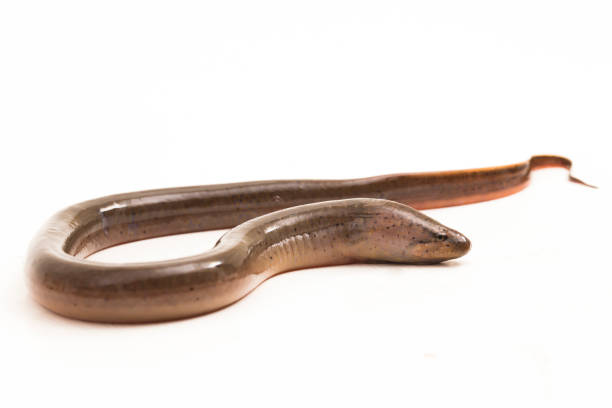The life cycle of eels has long captivated the imagination of scientists and nature enthusiasts alike. These creatures undergo a truly remarkable journey in order to reproduce.
In this piece, we will cover the fascinating lifecycle of the eel, shedding light on their reproductive process.
What Are Eels
Eels, often described as aquatic marvels, are a group of elongated, serpentine fish known for their sleek, cylindrical bodies and remarkable adaptability to various aquatic environments. These captivating creatures belong to the order Anguilliformes and can be found in both freshwater and saltwater habitats across the world.
Eels are known for their distinctive appearances, which include smooth, scaleless skin and a lack of pelvic fins. They possess a remarkable ability to move seamlessly through water, often with undulating, snake-like motions.
Eels come in a diverse range of species, each with its own unique characteristics and adaptations. Some well-known examples include the European eel, American eel, and the intriguing lamprey, a jawless eel-like species that differs significantly from its relatives.
Features Of Eels
Eels exhibit a range of distinctive features and adaptations that make them intriguing and well-suited for their aquatic environments. Here are some key features of eels:
- Elongated Bodies: Eels are known for their long, snake-like bodies. Their streamlined shape allows them to move gracefully through water with minimal resistance.
- Scaleless Skin: Unlike many other fish, eels lack scales. Their skin is typically smooth and covered in a protective layer of mucus, which helps reduce friction and makes them excellent swimmers.
- Lack of Pelvic Fins: Eels do not have pelvic fins, which are the paired fins located on the ventral side of most fish. This absence contributes to their streamlined appearance and agile swimming.
- Jawed or Jawless: Eels can be classified into two main groups: those with jaws and those without. Jawed eels have well-defined jaws with teeth, while jawless eels, like lampreys, possess a circular, sucker-like mouth with rows of tiny teeth.
- Diverse Species: Eels are a diverse group, with numerous species inhabiting freshwater, marine, and estuarine environments. Some eels are known for their migrations between these habitats, adding to their complexity.
- Nocturnal Behavior: Many eel species are nocturnal, meaning they are most active during the nighttime. Their keen sense of smell and excellent night vision help them locate prey and navigate in the dark.
- Longevity: Eels are known for their impressive lifespans. Some species can live for several decades, and in some cases, up to a century or more.
- Complex Life Cycle: Eels have a unique and complex life cycle that involves both freshwater and oceanic phases. They are catadromous, meaning they spawn in the ocean but spend most of their lives in freshwater or estuarine habitats.
- Migratory Abilities: Eels are renowned for their long-distance migrations. For instance, the European eel travels thousands of kilometers from its freshwater habitat to the Sargasso Sea in the Atlantic Ocean to spawn.
- Cultural Significance: Eels have cultural significance in various regions around the world, often featuring in traditional cuisine and folklore.
How Do Eels Reproduce?
The reproductive journey of eels is a captivating and complex process that spans different stages of life, from their early development in the ocean to their eventual return to freshwater habitats. Here’s an overview of how eels reproduce:
- Oceanic Spawning: Eels are catadromous, which means they spawn in the ocean. The exact location of their spawning grounds varies among different eel species, but one of the most famous spawning areas is the Sargasso Sea in the North Atlantic Ocean. Here, adult eels gather to release their eggs and sperm into the open water.
- Leptocephalus Larvae: After fertilization, eel eggs develop into tiny, leaf-shaped larvae called leptocephali. These transparent larvae are carried by ocean currents and undergo a remarkable transformation. During this phase, they may drift thousands of kilometers over several months.
- Metamorphosis: As leptocephali grow, they metamorphose into glass eels or elvers. This transformation involves changes in body shape and pigmentation. The elvers become more pigmented and develop into what are known as yellow eels.
- Migration to Freshwater: Yellow eels then migrate from the ocean back to freshwater or estuarine environments. They can navigate upstream in rivers and streams, sometimes overcoming significant obstacles such as waterfalls and dams.
- Maturation in Freshwater: In freshwater, eels continue to grow and mature. This phase can last for several years or even decades, depending on the species. Eels are known for their adaptability to different types of aquatic habitats.
- Silver Eel Stage: When eels are ready to reproduce, they undergo another transformation into a stage known as “silver eels.” During this phase, their bodies become silvery, and their eyes enlarge. Silver eels store up energy reserves for the arduous migration back to the ocean.
- Migration Back to the Ocean: Silver eels embark on a remarkable and long-distance migration back to the ocean, retracing the path they followed as young elvers but in the opposite direction. This migration can be thousands of kilometers, and it often involves navigating through oceanic currents.
- Spawning in the Ocean: Once they reach the ocean, the silver eels release their eggs and sperm into the open water, completing the life cycle. After spawning, adult eels typically die.
Frequently Asked Questions
What is the lifespan of eels?
The lifespan of eels can vary depending on the species. Some eels, such as the European eel, can live for several decades, and in certain cases, over a century. The longevity of eels is quite remarkable for fish.
Do all eels migrate to the ocean to spawn?
Yes, all eels are catadromous, which means they migrate from freshwater to the ocean to reproduce. This migration is a crucial part of their life cycle.
What is the significance of the Sargasso Sea for eels?
The Sargasso Sea, located in the North Atlantic Ocean, is a major spawning ground for some eel species, including the European eel. It is here that eels release their eggs and sperm into the open water.
4Are electric eels true eels?
No, electric eels are not true eels. They are a type of knifefish and are known for their ability to generate electric shocks, which they use for hunting and self-defense. True eels belong to the order Anguilliformes.
How do eels navigate such long migrations without getting lost?
The exact mechanisms eels use for navigation are still being studied. It’s believed that they rely on a combination of environmental cues, magnetic fields, and possibly celestial navigation. Their remarkable ability to return to specific spawning grounds remains a subject of ongoing research.
Conclusions
Eels are truly captivating and enigmatic creatures that have intrigued both scientists and nature enthusiasts for generations. Their extraordinary long-distance migrations, catadromous life cycle, and adaptability to diverse habitats make them stand out in the aquatic world.
References
- Wikipedia.org – Eel
- Smithsonianmag.co – Utterly Engrossing Search For The Origin Of Eels
- Pbs.org – Eel Fact Sheet





